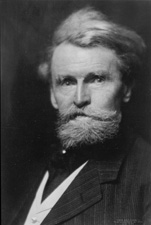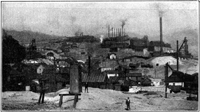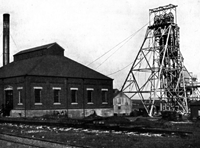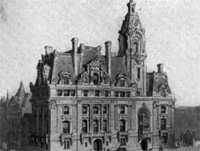|
SENATOR WILLIAM CLARK
A Biographical Sketch of William
Andrews Clark from the files of United Verde Copper Company
 William Andrews Clark, ex-United
States Senator, was born near Connellsville, Pa., January 8, 1839, son
of John and Mary (Andrews) Clark. He was a descendant of a Huguenot
family which had emigrated from France to Scotland to escape religious
persecutions, later moving to the north of Ireland, and then settling
in Pennsylvania soon after the close of the Revolutionary War. William Andrews Clark, ex-United
States Senator, was born near Connellsville, Pa., January 8, 1839, son
of John and Mary (Andrews) Clark. He was a descendant of a Huguenot
family which had emigrated from France to Scotland to escape religious
persecutions, later moving to the north of Ireland, and then settling
in Pennsylvania soon after the close of the Revolutionary War.
His father was a farmer and his
boyhood days were spent on the homestead, where he enjoyed the
advantages of three months’ winter school and nine months of farm
work. In 1856 his father moved to Van Buren County, Iowa, and there
developed a large and productive farm, in which his son had his share
of work to do. He taught school for several winter terms, then entered
an academy at Birmingham, Iowa, later attending the Iowa Wesleyan
University at Mt. Pleasant, where he studied in the academic and law
departments. In 1859-1860 he taught school in Missouri, and from then
on his life was entirely given over to the building up of the new
empire in the west.
 In 1862 he crossed the great
plains, driving a team to South Park, Colorado, and that winter worked
in the quartz mines in Central City, gaining knowledge and experience
for his future life in the mining industry. In 1863 news of the gold
discoveries at Bannock, Montana, reached Colorado and he was among the
first to start for this new El Dorado. After 65 days’ travel with an
ox-team, he arrived in Bannock, just in time to join a stampede to
Horse Prairie Creek, where he secured a claim. After several years’
experience in placer mining, he engaged in wholesale mercantile
enterprises which continued for about five years. During this time his
travels took him to the mining camps of Virginia City, Blackfoot City,
Helena and Elk Creek, to San Francisco and central California to
Portland, Oregon. In addition he also successfully carried on the
duties of a mail contractor on the star route between Missoula,
Montana, and Walla Walla, Washington. In 1862 he crossed the great
plains, driving a team to South Park, Colorado, and that winter worked
in the quartz mines in Central City, gaining knowledge and experience
for his future life in the mining industry. In 1863 news of the gold
discoveries at Bannock, Montana, reached Colorado and he was among the
first to start for this new El Dorado. After 65 days’ travel with an
ox-team, he arrived in Bannock, just in time to join a stampede to
Horse Prairie Creek, where he secured a claim. After several years’
experience in placer mining, he engaged in wholesale mercantile
enterprises which continued for about five years. During this time his
travels took him to the mining camps of Virginia City, Blackfoot City,
Helena and Elk Creek, to San Francisco and central California to
Portland, Oregon. In addition he also successfully carried on the
duties of a mail contractor on the star route between Missoula,
Montana, and Walla Walla, Washington.
In his various undertakings he had
been eminently successful and in 1868 he formed a partnership which
engaged in the wholesale mercantile and banking business, locating at
Helena, Montana, later moving to Deer Lodge, and, after buying out his
partners, this resulted in the locating at Butte of the banking firm
of W.A. Clark & Brother.
However, it was principally in the
mining field that he devoted most of his time and in which he made his
greatest success. In 1872 he was attracted to the quartz prospects of
Butte and purchased, in whole or in part, the Colusa, Original,
Mountain Chief, Gambetta and other mines, nearly all of which
developed into rich producers. The “Old Dexter,” the second stamp mill
of Butte, was finished in 1876 through his financial aid, and the
first smelter of consequence in Butte, the Colorado smelter, was
erected by a company organized by him. In 1880 he organized the
Moulton Company, which erected the Moulton Mill and developed the mine
of the same name. In 1914 he constructed a large concentrating plant
for the treatment of ores from the Elm Orlu mine, near Butte, which
mine developed into one of the largest zinc and copper mines of that
time. In the meantime he acquired and developed mining properties in
other western states, including coal properties in Colorado, in the
course of which he became interested in the United Verde mine in
Arizona, and it was this latter mine which his genius developed into
one of the best equipped mines in the world.
 When acting as Commissioner for
Montana to the exposition in New Orleans in 1885, he saw numerous
specimens exhibited from a mine in Arizona called the United Verde
mine. These specimens were rich in copper, gold and silver. Later on,
when re-organizing the Orford Copper Company, to which company he had
been selling the matte from his Butte smelters, he found on the books
numerous shipments of matte from the United Verde mine, which at that
time was operating two 50-ton furnaces. These mattes were extremely
rich in gold and silver contents. With his usual keenness, he started
to investigate and about the first of the year 1888, secured, through
the assistance of some New York friends, particularly Mr. James A.
Macdonald, who later became vice president of the company under Mr.
Clark’s reorganization, a second option on the United Verde mine
which, in spite of the rich surface ores, had up to that time been
unsuccessfully operated. His first visit to the mine was with his mine
superintendent, Joseph L. Giroux, in March 1888. Availing himself of
the fact that the first option had been given up, he immediately made
the first payment required under the option and proceeded to buy in as
much of the outstanding stock as was possible. The stock was scattered
all over the globe, and at the time of his death he and his family
owned about 299,000 shares out of 300,000. When acting as Commissioner for
Montana to the exposition in New Orleans in 1885, he saw numerous
specimens exhibited from a mine in Arizona called the United Verde
mine. These specimens were rich in copper, gold and silver. Later on,
when re-organizing the Orford Copper Company, to which company he had
been selling the matte from his Butte smelters, he found on the books
numerous shipments of matte from the United Verde mine, which at that
time was operating two 50-ton furnaces. These mattes were extremely
rich in gold and silver contents. With his usual keenness, he started
to investigate and about the first of the year 1888, secured, through
the assistance of some New York friends, particularly Mr. James A.
Macdonald, who later became vice president of the company under Mr.
Clark’s reorganization, a second option on the United Verde mine
which, in spite of the rich surface ores, had up to that time been
unsuccessfully operated. His first visit to the mine was with his mine
superintendent, Joseph L. Giroux, in March 1888. Availing himself of
the fact that the first option had been given up, he immediately made
the first payment required under the option and proceeded to buy in as
much of the outstanding stock as was possible. The stock was scattered
all over the globe, and at the time of his death he and his family
owned about 299,000 shares out of 300,000.
And so, having decided that the
mine held great possibilities, with his usual thoroughness and genius
for organizing and putting his desires into active operation, the
property was developed into one of the large copper producers of the
United States.
 In the foregoing biography there
has been purposely omitted reference to Senator Clark’s activities in
the fields of public utilities, water power undertakings, construction
and operation of railroads, ranching, manufacturing industries, etc.,
which in themselves are entitled to a separate recitation in order to
depict the many and varied ramifications of a brilliant intellect,
keen in its instantaneous grasp of values, combined with a force and
vitality to carry his convictions to a successful termination. In the foregoing biography there
has been purposely omitted reference to Senator Clark’s activities in
the fields of public utilities, water power undertakings, construction
and operation of railroads, ranching, manufacturing industries, etc.,
which in themselves are entitled to a separate recitation in order to
depict the many and varied ramifications of a brilliant intellect,
keen in its instantaneous grasp of values, combined with a force and
vitality to carry his convictions to a successful termination.
Senator Clark died in March 1925
and was survived by his second wife and six children.
Learn more about McIntyre & Bauman Group » |

|

![]()

![]()